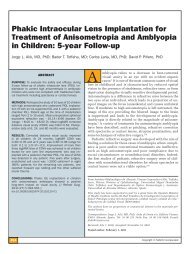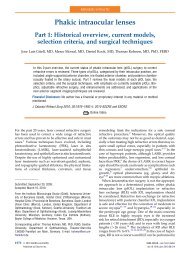PHAKIC FUTURE - LaserMed
PHAKIC FUTURE - LaserMed
PHAKIC FUTURE - LaserMed
Create successful ePaper yourself
Turn your PDF publications into a flip-book with our unique Google optimized e-Paper software.
OPHTHALMOLOGY WORLD REPORT DECEMBER 2007 SUPPLEMENT<br />
<br />
Late-breaking randomized trial<br />
Further support for<br />
Toric ICL over corneal ablation<br />
By Larry Schuster<br />
Reviewed by Dr. Donald R. Sanders, MD, PhD<br />
In a prospective, randomized study comparing the Visian<br />
Toric Implantable Collamer Lens (Toric ICL) and photorefractive<br />
keratectomy (PRK) in the correction of moderate to high<br />
myopic astigmatism, researchers found the Toric ICL performed<br />
better than the PRK in all key measures.<br />
The superior outcomes of the Toric ICL were evident in<br />
uncorrected visual acuity, refractive predictability, refractive<br />
stability, change in best spectacle-corrected visual acuity,<br />
change in contrast acuity, and glare symptoms. In addition,<br />
dry eye complaints were lower with the Toric ICL procedure.<br />
First author Steven Schallhorn, MD, Department of Ophthalmology,<br />
Navy Medical Center San Diego, San Diego, Calif.,<br />
and colleagues said the study provided further evidence that<br />
the Toric ICL is a viable alternative to existing refractive<br />
surgical treatments.<br />
Figure 1<br />
Figure 2<br />
“A number of other clinical trials have compared outcomes<br />
between the Visian ICL and LASIK or PRK, the researchers<br />
wrote in their paper, published in the Nov. 23 issue of the<br />
Journal of Refractive Surgery (J Refract Surg. 2007;23:853-<br />
867). “All showed superior results of the ICL for various<br />
refractive ranges. The outcomes of this comparison of PRK<br />
and the Toric ICL support these findings and demonstrate that<br />
in this study, Toric ICL correction results in a more effective<br />
procedure than PRK surgery.”<br />
They further note, “The dramatic improvement in outcome of<br />
the ICL over LASIK or PRK is not unexpected as it is more<br />
accurate to manufacture the exact correction required in a<br />
HEMA material than to ablate the correction onto corneal<br />
tissue, which is then subject to tissue healing.”<br />
Completed at the Naval Medical Center San Diego, USA, the<br />
study compared the clinical outcomes of PRK to the unapproved<br />
toric phakic IOL for the correction of moderate to high<br />
myopic astigmatism.<br />
It involved 43 eyes implanted with the Toric ICL (20 bilateral<br />
cases) and 45 eyes receiving PRK with mitomycin C (22<br />
bilateral cases) with moderate to high myopia ( 6.00 to 20.00<br />
diopters [D] sphere) measured at the spectacle plane and 1.00<br />
to 4.00 D of astigmatism. Patients were followed for 1 year.<br />
Patients had to be between the ages of 21 and 45 years, have a<br />
stable refraction for the last 12 months as documented by previous<br />
clinical records, and have a manifest refraction spherical<br />
equivalent (MRSE) progression at a rate of 0.50D or less<br />
during the year prior to the baseline examination.<br />
Patients with a history of previous intraocular surgery, diabetes,<br />
glaucoma, ocular hypertension, amblyopia, and/or any<br />
serious ophthalmic or non-ophthalmic conditions that may<br />
have precluded study completion were excluded.<br />
Figure 3<br />
in the PRK series in the early healing period (1 week; 19%<br />
vs 0%, P=.006). Improvement in BSCVA (2 or more lines)<br />
was statistically better in the Toric ICL group at 1-month<br />
follow-up (0% vs 10%, P=.010), and the entire distribution of<br />
change in BSCVA was statistically better with the Toric ICL<br />
at all visits through 12 months (P .001).<br />
The outcomes of this comparison of PRK<br />
and the Toric ICL ... demonstrate that in this<br />
study, Toric ICL correction results in a more<br />
effective procedure than PRK surgery.<br />
Improvement of 1 or more lines of BSCVA was better with<br />
the Toric ICL series at all time periods studied (P .001).<br />
Ninety-five percent of patients had an improvement of 1 or<br />
more lines of BSCVA in the Toric ICL series at 12-month<br />
follow-up compared to 39% in the PRK series.<br />
(See Figure 2).<br />
The proportion of cases with BSCVA of 20/12.5 or better<br />
was significantly higher in the Toric ICL group at all postoperative<br />
time periods (12 months; 71% vs 14%, P .001). Additionally,<br />
the proportion of cases with BSCVA 20/16 or better<br />
Figure 4 Figure 5<br />
was also significantly higher in the Toric ICL group at all<br />
postoperative periods. When using the entire distribution of<br />
BSCVA values and not just the breakdown of 20/12.5, 20/16,<br />
or 20/20, the Toric ICL had significantly better BSCVA at all<br />
postoperative visits between 1 week and 12 months (P .001).<br />
On adverse events, at 2 years postoperatively, the presence<br />
of a grade 2 anterior subcapsular cataract was noted in one<br />
(2.3%) Toric ICL patient. The patient had a preoperative<br />
refraction of 6.50 2.25 @ 170°. One month postoperatively,<br />
BSCVA was 20/25 (same as preoperatively) with a refraction<br />
of 0.25 0.50 @ 019° and a clear crystalline lens.<br />
The patient subsequently was lost to follow-up until 2 years<br />
later. Best corrected vision at that time was 20/50.<br />
On effectiveness outcomes, uncorrected visual acuity<br />
improved dramatically in both groups. The proportion of<br />
cases seeing 20/12.5 or better and 20/16 or better was significantly<br />
higher in the Toric ICL group at all postoperative<br />
time periods. Using the entire distribution of UCVA values<br />
and not just 20/12.5, 20/16, or 20/20 cutoffs, the Toric ICL<br />
was significantly better than PRK at all follow-up examinations<br />
(P .001).<br />
The Toric ICL showed a much larger percentage of eyes in<br />
which the postoperative UCVA was better than the preoperative<br />
BSCVA (61% vs 18%). Looking at the entire distribution<br />
of the relationship between preoperative BSCVA to<br />
the 12-month UCVA outcomes for the Toric ICL and PRK<br />
procedures, the Toric ICL was statistically better (P .001).<br />
(See Figure 3).<br />
Predictability (attempted vs achieved correction) favored the<br />
Toric ICL numerically at all postoperative visits ( 0.50D and<br />
1.00D) and was statistically better at all time points except<br />
12 months with regard to 0.50D (76% vs 57%, P=.101). The<br />
scattergrams at 12 months postoperatively demonstrate more<br />
variability in the PRK group and a tendency to overcorrect.<br />
(See Figures 4 and 5).<br />
RESULTS<br />
On best spectacle-corrected visual acuity, the mean change<br />
was significantly better with the Toric ICL than with PRK at<br />
all time periods from 1 week through 12-month follow-up. At<br />
all time periods, the Toric ICL group demonstrated significantly<br />
more improvement in BSCVA than the PRK group<br />
(P .001). (See Figure 1).<br />
Loss of 2 or more lines of BSCVA was significantly higher




